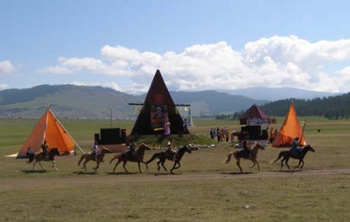Home page
» HISTORY
» Turkic tribes of Azerbaijan
Turkic tribes of Azerbaijan The ancient Turkic tribes of Azerbaijan Arattas Lullubis Qutis In the third millennium BC around the west and south –west parts of Lake Urmiya tribal union of Quti tribes was available. They united as a state after the second half of that millennium. Qutis were allies with Sumerians, but strongly objected to the aggressive policy of Akkadians. Quti state was the union kins. It was consisted of subar, turuk, ckuman, bars, bori, gargar, azeri, zengi and so on Turkic tribes. Sources said that at the end of XXIII century BC qutis were removed from Mesopotamia. Their rule lasted 91 years and 40 days. Quti’s most important feature was its democratic management. The capital of Quti was present Kirkuk (Arrapha) city. Turukkis The geographical area of living of Turukkis covered an area from Lake Urmiya to Zanjan. Turukkis emerged in the stage of history together with qutis and lullubis. At the end of third millennium BC and early second millennium BC the language of tribes and other ethnic groups lived in the territory of Azerbaijan was united in bigger language group of Zaqr-Elam, Zaqros, Kaspi and others. Subars Subars also lived around the lake Urmiya Basin in the III-II millenniums. Subars contributed not only in formation of Azerbaijani but other Turkic peoples, too. Subars lived between the two rivers (Tigris-Euphrates), the Semitic tribes came here after united around the city-state of Akkad and had been a factor of its strengthening. Later, subars being subjected to attacks of Akkad, khuri, Semitic-Assyrian tribes were divided into three branches: the west, middle and east. A significant part of those settled in Urmiya Lake Basin moved towards Siberia and Turkestan. Siberia’s name is related with subars. Subars from the middle part settled in upper area of the Tigris and the Euphrates and in the west of Lake Van, between present Bitlis and Diyarbakir. Gargars One of the main tribes inhabiting the vast territories of Azerbaijan after Albanians were gargars. Gargars is very ancient ethnos. As there was no source, it is difficult to say something exact about their settlement in the Albania from the North Caucasus territory. There is information about gargars - one of the oldest Turkic tribes, in the work of Homer (“Iliad”) at early the first millennium. Gargars lived compactly. They were one of the main tribes of Albania and used to live in lower parts of Kura, in Artsakh, in the north-eastern Albania, as well as in the South Azerbaijan, the North Caucasus and present-day Armenia. Kaspis Semitic tribes had settled at the beginning of the third millennium BC in the north of the Euphrates, Tigris River. When Achaemenid\'s political influence reached the Northern Caucasus Mountains, living in the over the tribes began to appear on the stage of history. Most prominent of them is Kaspis and one name of the Caspian Sea - Kaspi is their memory. Kaspis are relatives of one of the strongest nations in ancient times - kassis. The area of their living is Mugan, Lankaran lowland.
|
